When you first try Aperol, you're likely to notice a unique interplay of sweetness and bitterness that's both intriguing and revitalizing. Imagine the distinct taste of sweet orange mingling with the tartness of rhubarb, all balanced by a gentle bitterness from gentian root and cinchona bark. But there's more to Aperol than just these flavors; its subtle herbal undertones, derived from a secret blend of ingredients, add an unexpected layer of complexity. Curious about how this vibrant, bittersweet liqueur can transform your favorite cocktails? Let's explore further.
Key Ingredients
At the heart of Aperol's distinctive taste are its key ingredients, each contributing a unique layer to its complex flavor profile. When you first sip Aperol, the immediate burst of citrus is unmistakable. This vibrant note primarily comes from sweet and bitter oranges. The sweet oranges lend a mellow, zesty sweetness, while the bitter orange peel introduces a slightly astringent edge that tantalizes your palate.
Rhubarb, another essential component, adds a tart and subtly bitter dimension to the Aperol taste. It's this combination of tartness and bitterness that gives Aperol its invigorating crispness, making it a favorite for spritz cocktails. As you explore deeper, you'll notice the layered complexity grows richer.
Gentian root is a fascinating ingredient in Aperol. Known for its medicinal properties, gentian root imparts a mild bitterness that's both earthy and floral. This bitterness is not overwhelming but rather harmonizes beautifully with the other flavors, adding depth and sophistication to each sip.
Cinchona bark, famous for being the source of quinine, plays a vital role. It introduces a recognizable bitterness, akin to what you might find in tonic water. This bitterness is sharp yet balanced, ensuring that the overall flavor remains intriguing and multi-dimensional.
Though the exact proprietary recipe of Aperol remains a closely guarded secret, these key ingredients form the backbone of its unique taste. The interplay of sweet and bitter oranges, rhubarb, gentian root, and cinchona bark creates a flavor profile that's both invigorating and complex, ensuring that every sip of Aperol is a delightful exploration of citrus and herbal notes.
Sweetness and Bitterness
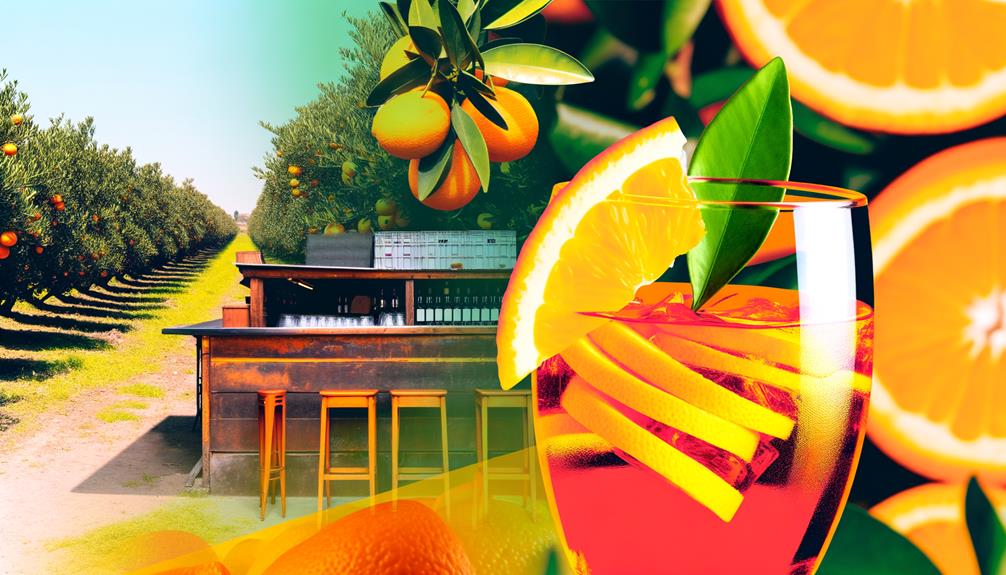
When you first taste Aperol, the interplay of sweetness and bitterness immediately captivates your palate. This remarkable balance is what defines Aperol's distinctive flavor profile. Initially, you'll notice a sweet taste, primarily derived from its sugar content. This sweetness is harmoniously contrasted by a mild but pleasant bitterness, offering a well-rounded experience.
The sweetness in Aperol is not overwhelming; it is delicately balanced by the bitterness that follows. The dominant flavors you'll detect include sweet orange and rhubarb. The bright, citrusy notes of sweet orange are evident from the first sip, providing a revitalizing sweetness. Meanwhile, rhubarb contributes a slight bitterness that perfectly complements the sweet undertones.
While Aperol's bitterness is milder compared to other Italian spirits, it is this subtle bitterness that makes it more approachable for those who might find stronger bitter liqueurs too intense. The bitterness is present, but it doesn't overpower; instead, it enhances the overall flavor profile, creating a delightful contrast.
To fully understand this balance, consider the following table that illustrates the key elements of Aperol's flavor:
| Element | Description |
|---|---|
| Initial Sweetness | Derived from sugar content, noticeable upfront |
| Sweet Orange | Dominant sweet flavor, revitalizing citrus notes |
| Rhubarb Bitterness | Slight bitterness, balances the sweetness |
| Overall Bitterness | Milder compared to other spirits, more approachable |
| Flavor Profile | Harmonious balance of sweetness and bitterness |
This delicate dance between sweetness and bitterness is what makes Aperol so intriguing. The sweetness invites you in, while the bitterness keeps your taste buds engaged, making it an unforgettable flavor experience.
Herbal Notes
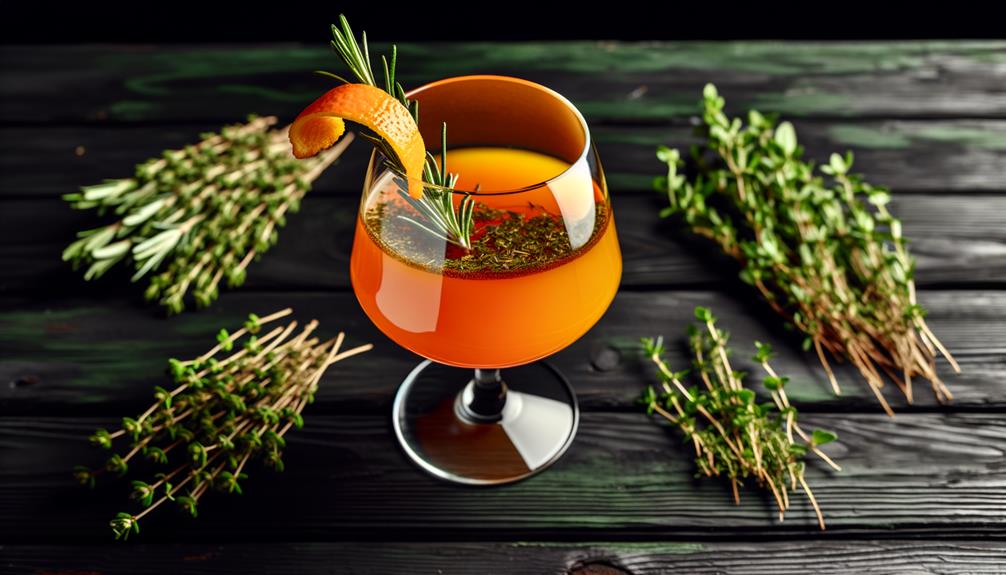
Amidst the interplay of sweetness and bitterness, Aperol's herbal notes offer an additional layer of complexity that truly sets it apart. These herbal infusions are derived from a secret blend of medicinal herbs and roots, meticulously crafted to create a unique flavor profile that intrigues and delights the palate. The presence of gentian root imparts a slightly bitter undertone, harmoniously balanced by other herbal ingredients.
As you savor Aperol, you'll notice a mild, slightly bitter flavor from the gentian root. This bitterness is delicately complemented by the subtle tartness of rhubarb, adding an intricate depth to the overall taste experience. Rhubarb's contribution guarantees the herbal flavors are never overwhelming but instead create a refined and balanced sensation.
To paint a vivid picture of Aperol's herbal complexity, consider the following elements:
- Gentian Root: Provides a slightly bitter base, essential for the drink's balanced profile.
- Rhubarb: Adds a touch of tartness, enhancing the herbal blend with subtle depth.
- Medicinal Herbs and Roots: A secret blend that imparts a delicate, invigorating quality ideal for an aperitif.
- Harmonious Shift: The herbal notes seamlessly shift from sweetness to bitterness, appealing to a wide range of palates.
This symphony of flavors guarantees that Aperol can be enjoyed in various settings, whether as a pre-meal aperitif or a invigorating cocktail component. The slightly bitter, herbaceous notes provide a light yet stimulating quality, making each sip a delightful exploration of complex tastes. By understanding these herbal notes, you can better appreciate the nuanced craftsmanship behind Aperol, making it a truly exceptional and versatile spirit.
Citrus Flavors
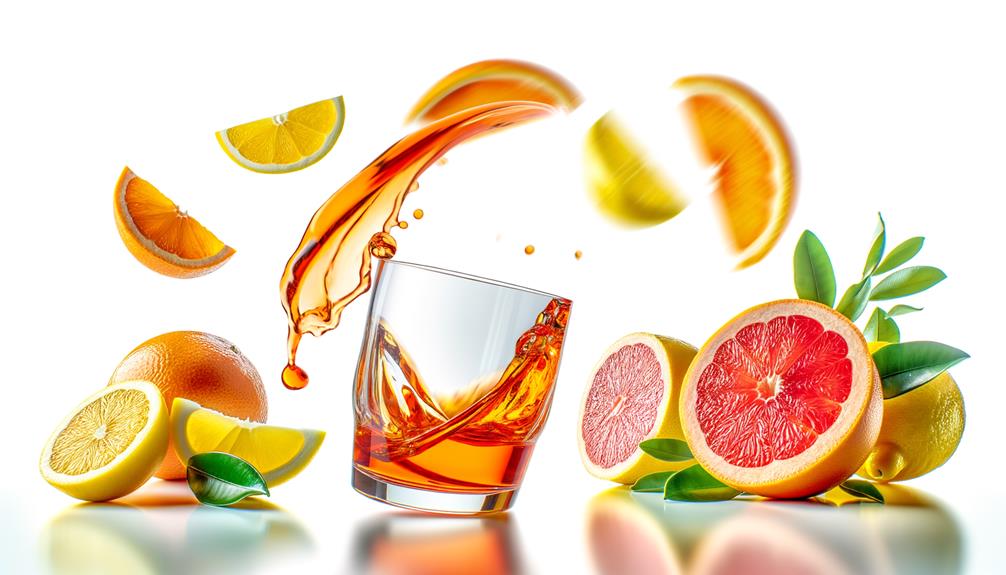
As you savor Aperol, you'll immediately notice the bold orange flavor, evocative of zesty orange peel rather than simple juice. This citrus foundation is artfully balanced by tart rhubarb undertones, adding a invigorating tang that keeps your palate intrigued. Combined with a subtle sweetness and mild bitterness, Aperol's citrus profile offers a vibrant and layered tasting experience perfect for warm summer evenings.
Dominant Orange Notes
Aperol's flavor profile is dominated by vibrant orange notes, which bring a zesty and invigorating character to the liqueur. These citrus flavors are derived from both sweet and bitter oranges, giving Aperol its unique balance. The orange taste in Aperol is more akin to the zestiness of orange peel rather than typical orange juice, making it less sweet and more complex.
When you're crafting an Aperol Spritz, the dominant orange notes come alive, balancing perfectly with the prosecco and soda water. Here's what you can expect:
- Zesty Citrus: The bright, almost tangy quality of orange peel hits your palate first, delivering a fresh and lively sensation.
- Balanced Sweetness: While the liqueur is less sweet than many other orange-flavored spirits, the subtle sweetness complements the bitterness seamlessly.
- Vibrant Color: The vivid orange hue visually reflects the intense citrus flavors, making your Aperol Spritz as appealing to the eye as it is to the taste buds.
- Versatile Ingredient: The infusion of orange flavors makes Aperol a standout in various cocktails, offering an invigorating twist to your mixology repertoire.
Tart Rhubarb Undertones
Particularly, Aperol features tart rhubarb undertones that add a distinctive layer to its flavor profile, striking a perfect balance between sweetness and bitterness. The tart rhubarb is not just a background note; it plays a vital role in complementing the prominent sweet orange flavors. This combination enhances the overall complexity of the drink, making every sip an intricate dance of tastes.
The tartness of rhubarb is especially noticeable on your palate, providing a revitalizing zing that flows smoothly into the bittersweet finish characteristic of Aperol. This unique tartness is why rhubarb is often considered a key ingredient, alongside gentian root and cinchona bark, which further enrich the liqueur's flavor spectrum.
| Flavor Component | Role in Aperol | Sensory Experience |
|---|---|---|
| Tart Rhubarb | Key Ingredient | Noticeable tartness |
| Sweet Orange Flavors | Complementary | Sweet, citrusy notes |
| Bittersweet Finish | Defining Trait | Smooth flow |
| Gentian Root | Supporting | Earthy bitterness |
| Cinchona Bark | Supporting | Slight astringency |
This interplay between tart rhubarb and citrus flavors makes Aperol a revitalizing choice, particularly in summer cocktails like the Aperol Spritz, where its complex flavor profile can truly shine.
Comparisons to Other Spirits
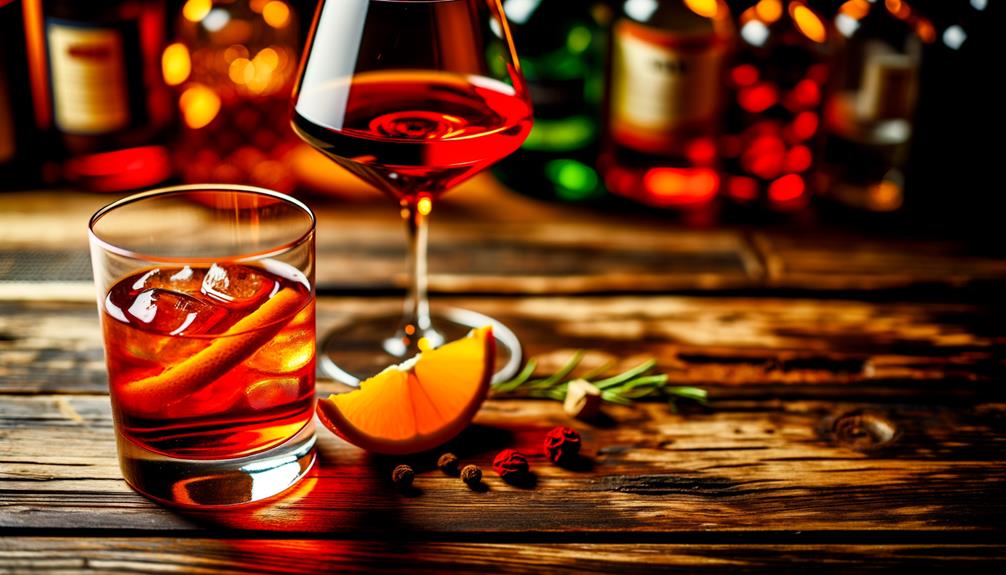
When comparing Aperol to other spirits, especially its close relative Campari, you'll notice several distinct differences that set it apart. First and foremost, Aperol is less potent, with an alcohol content of 11%, making it notably lighter than Campari, which ranges from 20.5% to 25.8% ABV. This lower alcohol content makes Aperol an appealing choice for those who prefer a milder drink.
Taste-wise, Aperol is less bitter and features a harmonious blend of sweet orange notes complemented by mild bitterness from gentian root and rhubarb. Campari, on the other hand, is renowned for its intense bitterness and complex, layered flavors of wood and floral notes. This makes Aperol more approachable for those who favor a slightly sweeter and less bitter aperitivo.
To paint a clearer picture of how Aperol compares to other spirits, consider the following:
- Alcohol Content: Aperol's 11% ABV versus Campari's higher range of 20.5% to 25.8%.
- Flavor Profile: Aperol offers sweet orange and mild bitterness; Campari is intensely bitter with wood and floral notes.
- Sweetness: Aperol is generally sweeter, making it more appealing to those who prefer a less bitter taste.
- Color: Aperol has a bright orange hue, while Campari is darker and more ruby-red.
Visually, Aperol's vibrant orange color stands out, contrasting with Campari's deeper ruby-red shade. This brightness hints at its lighter, fruitier taste, making it a popular choice in invigorating spritzes. In contrast, Campari's robust profile is essential for bolder cocktails like the Negroni, showcasing its intense bitterness and complex flavors. Whether you're a fan of lighter, sweeter spirits or prefer something with a bit more punch, understanding these differences can help you choose the perfect aperitivo for any occasion.
Popular Cocktails
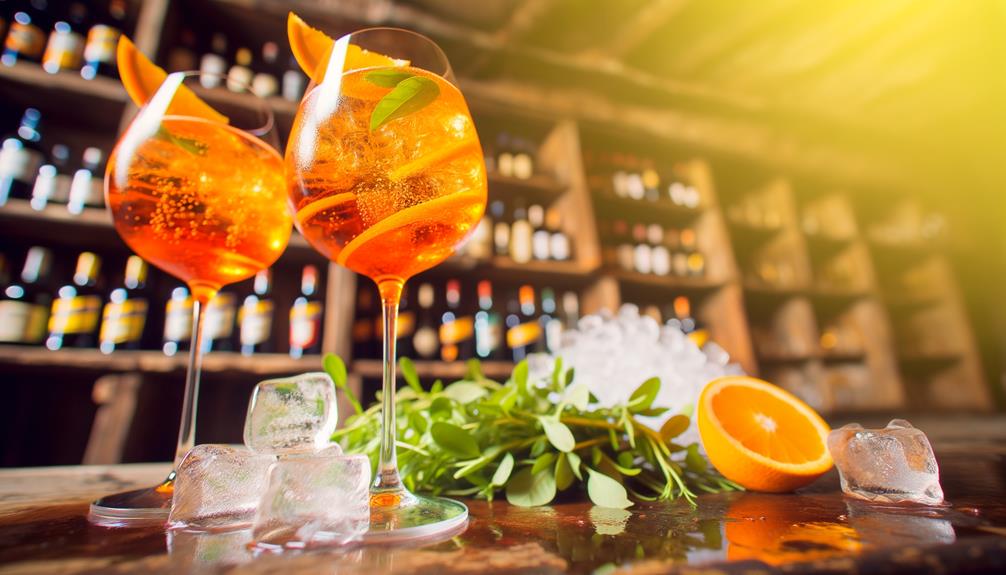
When it comes to classic Aperol cocktails, the Aperol Spritz stands out with its invigorating mix of Aperol, Prosecco, and club soda, making it a quintessential summer drink. You'll also find the Aperol Sour intriguing, as it combines the vibrant flavors of lemon juice and simple syrup with a frothy egg white finish. For a sophisticated twist, try the Negroni Sbagliato, where Prosecco replaces gin for a lighter, effervescent experience.
Aperol Spritz Recipe
Imagine a sun-drenched Italian terrace, where the clinking of glasses and laughter fill the air; this is the perfect setting to enjoy an Aperol Spritz. This quintessential summer drink is a delightful balance of flavors, perfect for leisurely afternoons. To craft this classic cocktail, follow this simple recipe:
- Fill a large wine glass with ice – the foundation for a perfectly chilled drink.
- Add 2 parts Aperol – its vibrant orange hue and bittersweet taste set the tone.
- Pour in 3 parts Prosecco – the effervescence brings a light, crispness.
- Top with 1 part club soda – a splash of fizz to round it off.
Finish with a slice of orange for a touch of citrusy elegance. With an alcohol content of about 11%, the Aperol Spritz is light enough for pre-dinner enjoyment, embodying the Italian tradition of aperitivo. You can experiment with variations; try substituting Chardonnay for Prosecco or adding frozen fruits for a twist. Pair it with Mediterranean appetizers or salty snacks to enhance the revitalizing and slightly bitter taste profile. This classic recipe guarantees that your summer gatherings are infused with a touch of Italian charm.
Classic Aperol Cocktails
On a warm summer evening, there's nothing quite like indulging in classic Aperol cocktails that capture the essence of Italian aperitivo culture. These vibrant drinks, with their unique balance of bitter and sweet, are perfect for any occasion.
The Aperol Spritz reigns supreme as the quintessential summer cocktail. It combines equal parts Aperol and Prosecco, topped off with soda water, and garnished with an orange slice. This invigorating beverage is a harmonious blend of flavors that's hard to beat.
Another standout is the Paper Plane, which mixes equal parts Aperol, bourbon, Amaro Nonino, and fresh lemon juice. This cocktail offers a balanced interplay of bitter, sweet, and citrus notes, making it a sophisticated choice.
For something a bit different, try the Spaghett. This light and herbaceous drink includes Aperol, gin, and vermouth, making it ideal for aperitivo hour.
Lastly, the Aperol Tonic and Boulevardier both provide unique twists. The Aperol Tonic pairs Aperol with tonic water, garnished with a slice of grapefruit or orange for a slightly bitter taste. The Boulevardier substitutes bourbon for gin in a Negroni, blending Aperol, sweet vermouth, and bourbon for a richer profile.
| Cocktail | Key Ingredients |
|---|---|
| Aperol Spritz | Aperol, Prosecco, soda water, orange slice |
| Paper Plane | Aperol, bourbon, Amaro Nonino, lemon juice |
| Spaghett | Aperol, gin, vermouth |
| Aperol Tonic | Aperol, tonic water, grapefruit/orange slice |
Personal Impressions
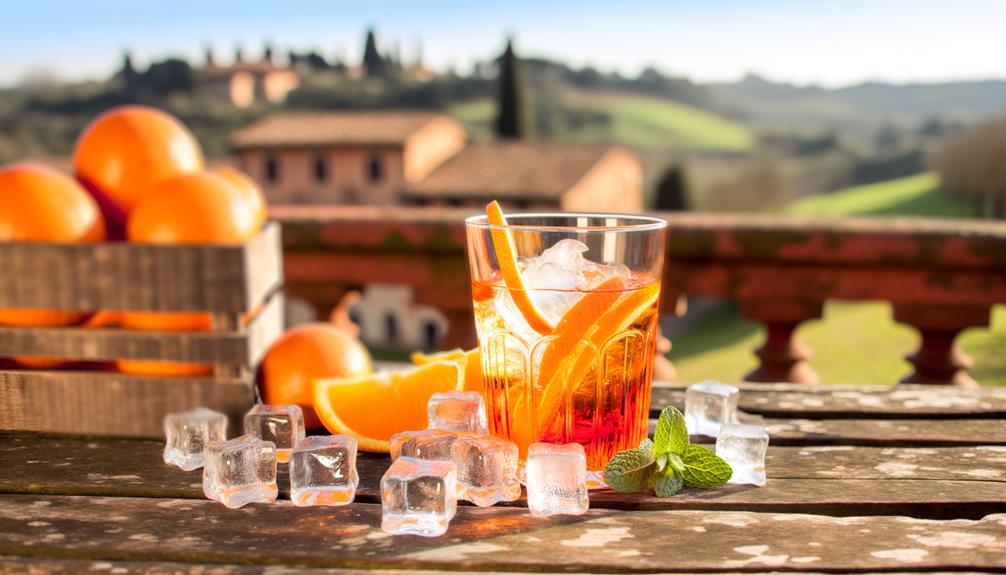
Savoring Aperol for the first time often elicits a spectrum of reactions, revealing its intricate layers to each individual uniquely. As you take that initial sip, the vibrant, bright orange hue catches your eye, setting the stage for a multifaceted tasting experience. The drink starts with a sweet citrusy note, reminiscent of fresh oranges, balanced by a subtle sugar content that makes it inviting.
However, as the liquid lingers on your palate, the complexity of Aperol begins to unfold. You'll notice a shift from sweet to a mild, yet distinct bitterness, primarily attributed to the tart rhubarb and the proprietary blend of herbs and roots. This alteration can be quite polarizing, with some finding the bitterness an intriguing contrast, while others may compare it to less favorable flavors like cough syrup.
To paint a clearer picture, consider these common impressions from first-time drinkers:
- Sweet and Fruity: The initial burst of sweet orange is often described as invigorating and bright, a delightful start to the tasting journey.
- Slightly Bitter: The mild bitterness that follows can be surprising, adding depth and complexity that some may need to acquire a taste for.
- Herbal Undertones: The secret blend of herbs and roots imparts a unique, aromatic flavor that enhances the overall profile.
- Light and Invigorating: Compared to Campari, Aperol is lighter and less intense, making it a popular choice for those seeking a refreshing aperitif.
Ultimately, your personal impression of Aperol will depend on your palate's receptiveness to its balance of sweetness, bitterness, and herbal complexity.
Conclusion
In principle, Aperol's unique blend of sweet orange, tart rhubarb, and subtle bitterness from gentian root and cinchona bark creates a harmonious symphony of flavors. Its herbal undertones add a layer of complexity, making it both invigorating and versatile in cocktails. Whether you're sipping it in a classic Aperol Spritz or experimenting with new recipes, Aperol's vibrant taste and enchanting color guarantee an unforgettable experience. You've got a truly distinctive spirit in your glass.